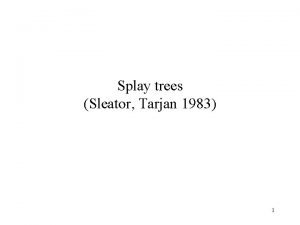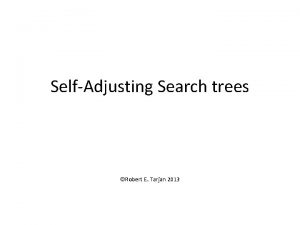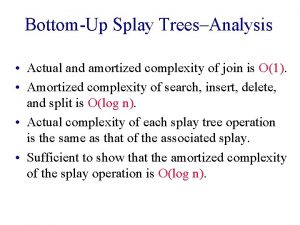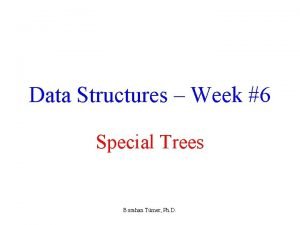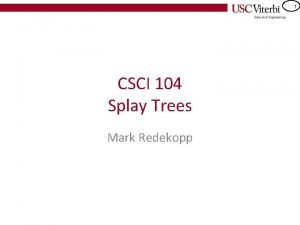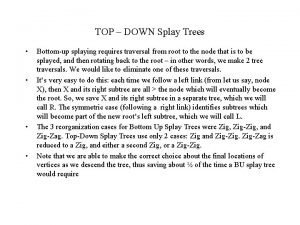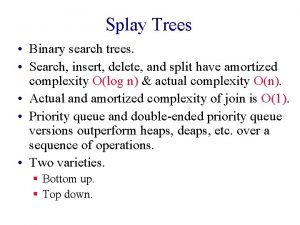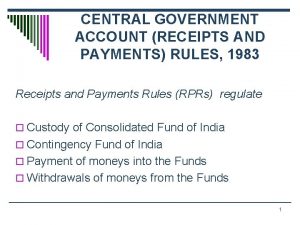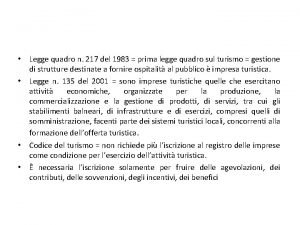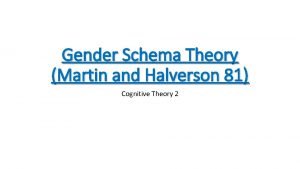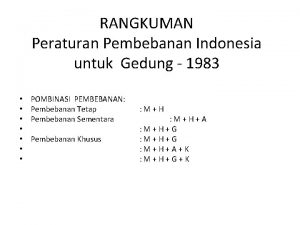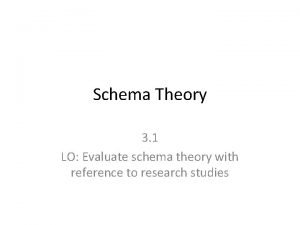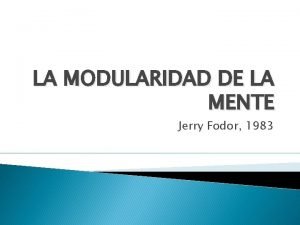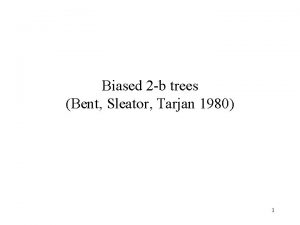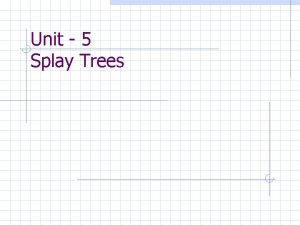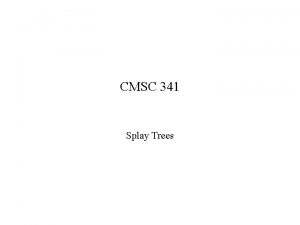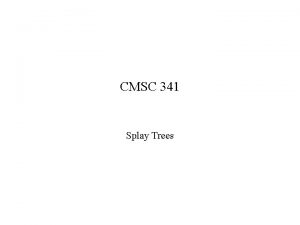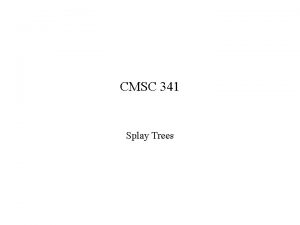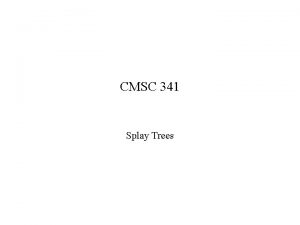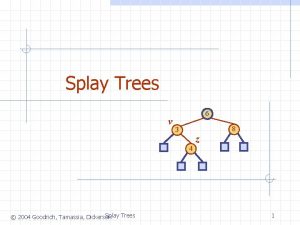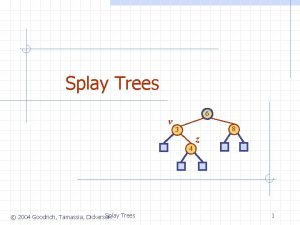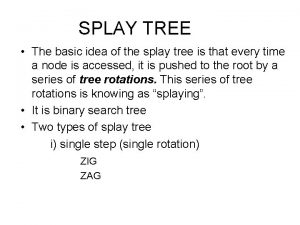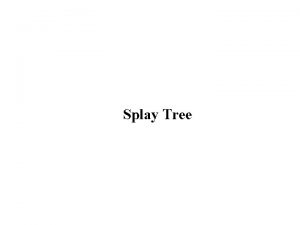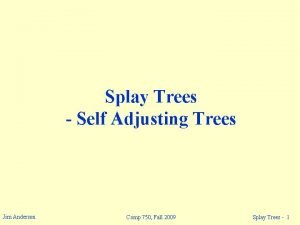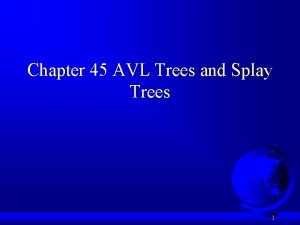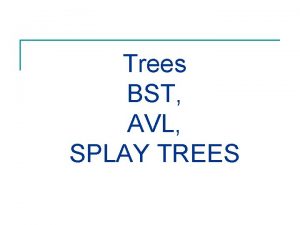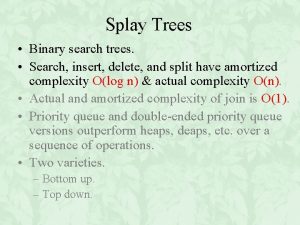Splay trees Sleator Tarjan 1983 1 Goal Support






































- Slides: 38

Splay trees (Sleator, Tarjan 1983) 1

Goal Support the same operations as previous search trees. 2

Highlights • binary • simple • good amortized property • very elegant • interesting open conjectures -- further and deeper understanding of this data structure is still due 3

Main idea • Try to arrange so frequently used items are near the root • We shall assume that there is an item in every node including internal nodes. We can change this assumption so that items are at the leaves. 4

First attempt Move the accessed item to the root by doing rotations y x <===> x C A B A y B C 5

Move to root (example( e d b a C b C E c a B F a E A D d F c E A e d F c B e A b B C D D 6

Move to root (analysis( There arbitrary long access sequences such that the time per access is O(n) ! 7

Splaying Does rotations bottom up on the access path, but rotations are done in pairs in a way that depends on the structure of the path. A splay step: z (1) zig - zig ==> y x A D C B x y A z B C D 8

Splaying (cont( z (2) zig - zag x ==> y x A y D B A B D x ==> x A C C y (3) zig z C B y A B C 9

Splaying (example( i i h g f ==> J g I f H e A d b C e D E c F C E H a d e b B c F C J I f G b a g A a B h I d G J ==> H A c B h i F G E D D 10

Splaying (example cont( i h g J ==> a J a ==> h I f H f a A d e b B h I f F A G e d b B E E D C F H g d A g c c C i e b B c G C F i H I G E D D 11 J

Splaying (analysis( Assume each item i has a positive weight w(i) which is arbitrary but fixed. Define the size s(x) of a node x in the tree as the sum of the weights of the items in its subtree. The rank of x: r(x) = log 2(s(x)) Measure the splay time by the number of rotations 12

Access lemma The amortized time to splay a node x in a tree with root t is at most 3(r(t) - r(x)) + 1 = O(log(s(t)/s(x))) Potential used: The sum of the ranks of the nodes. This has many consequences: 13

Balance theorem Balance Theorem: Accessing m items in an n node splay tree takes O((m+n) log n) Proof. Assign weight of 1/n to each item. The total weight is then W=1. To splay at any item takes 3 log(n) +1 amortized time the total potential drop is at most n log(n) More consequences after the proof. 14

Proof of the access lemma The amortized time to splay a node x in a tree with root t is at most 3(r(t) - r(x)) + 1 = O(log(s(t)/s(x))) proof. Consider a splay step. Let s and s’, r and r’ denote the size and the rank function just before and just after the step, respectively. We show that the amortized time of a zig step is at most 3(r’(x) - r(x)) + 1, and that the amortized time of a zig-zig or a zig-zag step is at most 3(r’(x) -r(x)) The lemma then follows by summing up the cost of all splay steps 15

Proof of the access lemma (cont( y (3) zig ==> x A x C B y A B C amortized time(zig) = 1 + r’(x) + r’(y) - r(x) - r(y) 1 + r’(x) - r(x) 1 + 3(r’(x) - r(x)) 16

Proof of the access lemma (cont( ==> y x A x z (1) zig - zig D y A C z B B C D amortized time(zig) = 1 + = 2 + r’(x) + r’(y) + r’(z) - r(x) - r(y) - r(z) = 2 + r’(y) + r’(z) - r(x) - r(y) 2 + r’(x) + r’(z) - 2 r(x) 2 r’(x) - r’(z) + r’(x) + r’(z) - 2 r(x) = 3(r’(x) - r(x)) 17

Proof of the access lemma (cont( z (2) zig - zag x ==> y x A B y D A z B C D C Similar. (do at home) 18

More consequences Suppose all items are numbered from 1 to n in symmetric order. Let the sequence of accessed items be i 1, i 2, . . , im Static finger theorem: Let f be an arbitrary fixed item, the total m access time is O(nlog(n) + m + j=1 log(|ij-f| + 1)) Splay trees support access within the vicinity of any fixed finger as good as finger search trees. 19

Static optimality theorem For any item i let q(i) be the total number of time i is accessed Static optimality theorem: If every item is accessed at least once n the total access time is O(m + q(i) log (m/q(i)) ) i=1 Optimal average access time up to a constant factor. 21

Static optimality theorem (proof( Static optimality theorem: If every item is accessed at least once n the total access time is O(m + q(i) log (m/q(i)) ) i=1 Proof. Assign weight of q(i)/m to item i. Then W=1. Amortized time to splay at i is 3 log(m/q(i)) + 1 Maximum potential drop over the sequence is n log(W)- log (q(i)/m) i=1 22

Application: Data Compression via Splay Trees Suppose we want to compress text over some alphabet Prepare a binary tree containing the items of at its leaves. To encode a symbol x: • Traverse the path from the root to x spitting 0 when you go left and 1 when you go right. • Splay at the parent of x and use the new tree to encode the next symbol 23

Compression via splay trees (example( a b c d e f g h c aabg. . . d e f g h 000 24

Compression via splay trees (example( a b c d e f g h c aabg. . . d e f g h 0000 25

Compression via splay trees (example( a b c c d e f g h h aabg. . . 000010 26

Compression via splay trees (example( a b c c d e f g h h aabg. . . 0000101110 27

Decoding Symmetric. The decoder and the encoder must agree on the initial tree. 28

Compression via splay trees (analysis( How compact is this compression ? Suppose m is the # of characters in the original string The length of the string we produce is m + (cost of splays) by the static optimality theorem m + O(m + q(i) log (m/q(i)) ) = O(m + q(i) log (m/q(i)) ) Recall that the entropy of the sequence q(i) log (m/q(i)) is a lower bound. 29

Compression via splay trees (analysis( In particular the Huffman code of the sequence is at least q(i) log (m/q(i)) But to construct it you need to know the frequencies in advance 30

Compression via splay trees (variations( D. Jones (88) showed that this technique could be competitive with dynamic Huffman coding (Vitter 87) Used a variant of splaying called semi-splaying. 31

Semi - splaying Regular zig z y *x A == > D y A C C z D C D * y ==> y *x z B B Semi-splay zig - zig A *x x A z B C D B Continue splay at y rather than at x. 32

Update operations on splay trees Catenate(T 1, T 2): Splay T 1 at its largest item, say i. Attach T 2 as the right child of the root. i T 1 T 2 T 1 i T 2 T 1 T 2 s(T 1) + s(T 2) Amortize time: 3(log(s(T 1)/s(i)) + 1 + log( ) s(T 1) ≤ 3 log(W/w(i)) + O(1) 38

Update operations on splay trees (cont( split(i, T): Assume i T Splay at i. Return the two trees formed by cutting off the right son of i i i T T 1 T 2 Amortized time = 3 log(W/w(i)) + O(1) 39

Update operations on splay trees (cont( split(i, T): What if i T ? Splay at the successor or predecessor of i (i- or i+). Return the two trees formed by cutting off the right son of i or the left son of i ii. T T 1 T 2 Amortized time = 3 log(W/min{w(i-), w(i+)}) + O(1) 40

Update operations on splay trees (cont( insert(i, T): Perform split(i, T) ==> T 1, T 2 Return the tree i T 1 T 2 W-w(i) ) + log(W/w(i)) + O(1) Amortize time: 3 log( min{w(i-), w(i+)} 41

Update operations on splay trees (cont( delete(i, T): Splay at i and then return the catenation of the left and right subtrees i + T 1 T 2 Amortize time: 3 log(W/w(i)) + 3 log( W-w(i) w(i-) ) + O(1) 42

Open problems Self adjusting form of a, b tree ? 43

Open problems Dynamic optimality conjecture: Consider any sequence of successful accesses on an n-node search tree. Let A be any algorithm that carries out each access by traversing the path from the root to the node containing the accessed item, at the cost of one plus the depth of the node containing the item, and that between accesses perform rotations anywhere in the tree, at a cost of one per rotation. Then the total time to perform all these accesses by splaying is no more than O(n) plus a constant time the cost of algorithm A. 44
 Tarjan 1983
Tarjan 1983 Robert e tarjan
Robert e tarjan Emma turetsky
Emma turetsky Tarjn
Tarjn Robert e tarjan
Robert e tarjan Tarjan algorithm complexity
Tarjan algorithm complexity Splay tree amortized analysis
Splay tree amortized analysis Splay tree animation
Splay tree animation How to draw visibility splays
How to draw visibility splays Splay mark
Splay mark Top down splay tree
Top down splay tree Water splay
Water splay Splay tree tutorial
Splay tree tutorial Splay tree delete
Splay tree delete Martin from the elevator
Martin from the elevator What is the theme of the elevator
What is the theme of the elevator Discuss schema theory erq
Discuss schema theory erq Central government account (receipts and payments) rules
Central government account (receipts and payments) rules Everett m. rogers (1983)
Everett m. rogers (1983) Benedict anderson 1983
Benedict anderson 1983 Legge quadro 1983
Legge quadro 1983 Brainstorm 1983
Brainstorm 1983 Teori snehandu b. kar (1983)
Teori snehandu b. kar (1983) Pp nomor 10 tahun 1983
Pp nomor 10 tahun 1983 Traszka 1983
Traszka 1983 Dyna tac8000
Dyna tac8000 Bahagian pengurusan kurikulum
Bahagian pengurusan kurikulum Martin and halverson gender schema theory
Martin and halverson gender schema theory 1983
1983 Peraturan pembebanan indonesia untuk gedung 1983
Peraturan pembebanan indonesia untuk gedung 1983 1988 türkiye güzeli
1988 türkiye güzeli Evaluate schema theory
Evaluate schema theory Uu 6 1983
Uu 6 1983 Diamond and dybvig (1983) model
Diamond and dybvig (1983) model John/joan case
John/joan case Tucson flood 1983
Tucson flood 1983 Lawrence kohlberg wife
Lawrence kohlberg wife Kintsch y van dijk (1978)
Kintsch y van dijk (1978) Fodor 1983
Fodor 1983
